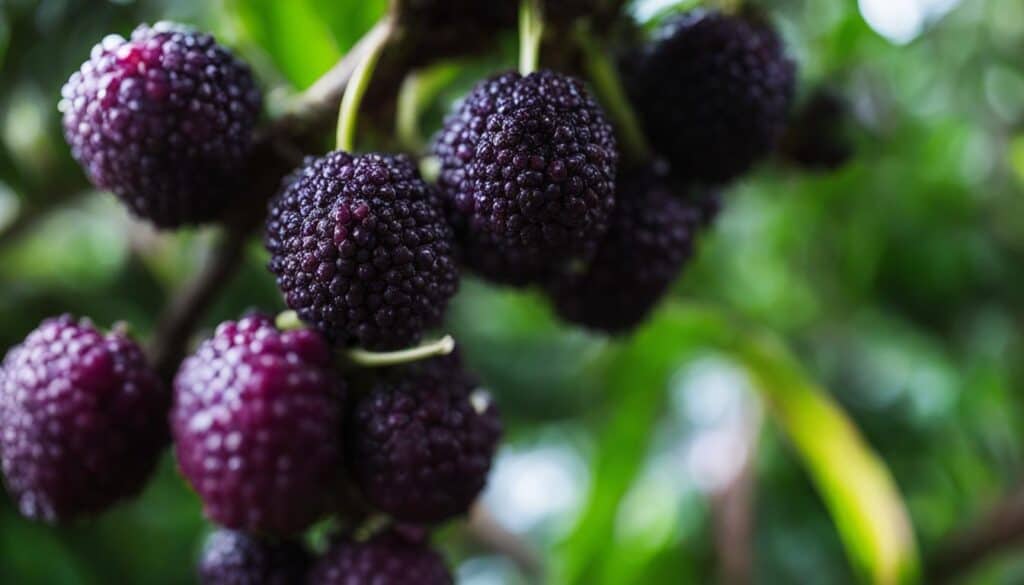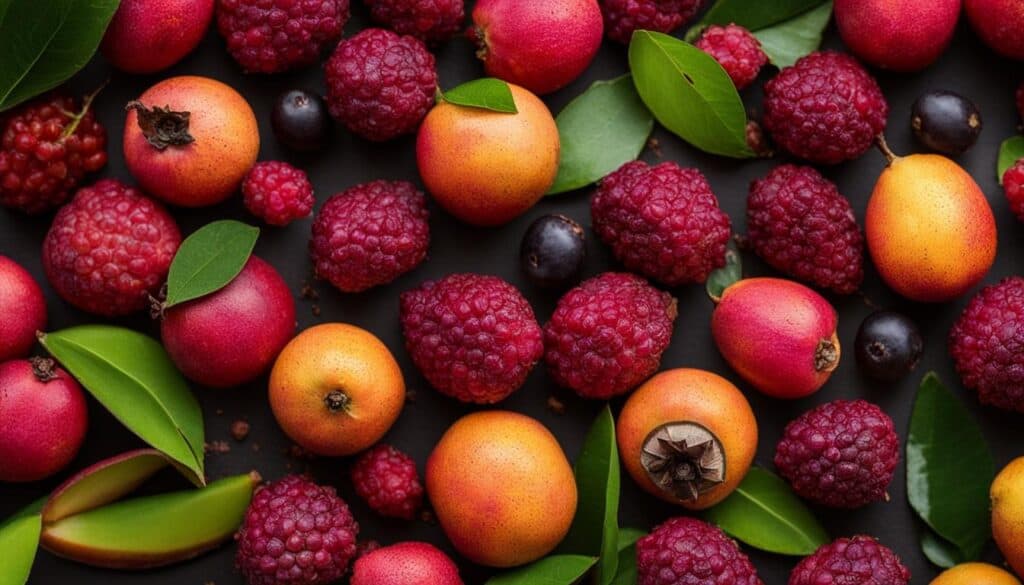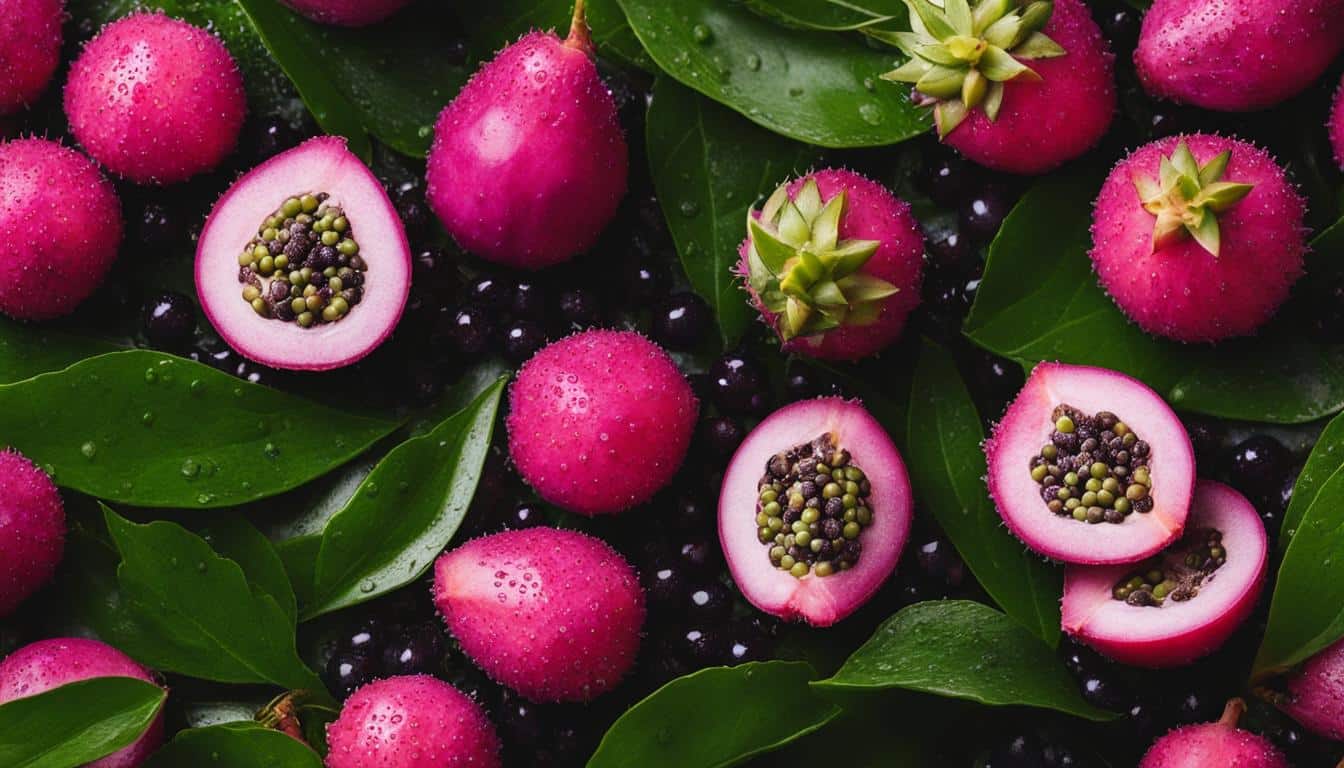Growing up in South Asia, I was always fascinated by the vibrant array of tropical fruits that adorned the markets. Falsa fruit, also known as Indian Sherbet Berry, was one such fruit that captured my attention with its unique flavor and beautiful appearance. Today, I am excited to share the wonders of falsa fruit with you and unveil its English name – a tropical delight that will surely leave you craving for more.
Key Takeaways:
- Falsa fruit is a tropical fruit native to South Asia, known for its sweet and tangy flavor.
- Its English name is “falsa fruit” or “Indian Sherbet Berry”.
- Falsa fruit offers various health benefits, including being rich in antioxidants and a good source of vitamins A and C.
- It is versatile in culinary use and can be enjoyed in drinks, desserts, and salads.
- Falsa fruit holds cultural significance in South Asian countries and is associated with summer celebrations.
Falsa Fruit Benefits and Uses
Falsa fruit, also known as Indian Sherbet Berry, not only tantalizes your taste buds with its sweet and tangy flavor but also offers a wide range of health benefits. Rich in antioxidants, this tropical fruit helps fight against free radicals, reducing the risk of chronic diseases.
Loaded with vitamins A and C, falsa fruit supports immune function and promotes healthy skin. Its anti-inflammatory properties can help reduce inflammation, while its high fiber content aids in digestion. Whether you enjoy falsa fruit in jams, jellies, sorbets, or refreshing beverages, this delicious fruit is sure to bring a burst of flavor and nutrition to your table.
Here are some key benefits and uses of falsa fruit:
Falsa Fruit Benefits and Uses:
- Antioxidant-rich: Falsa fruit is packed with antioxidants, which help protect your body against harmful free radicals and oxidative stress.
- Immune-boosting: With its high vitamin C content, falsa fruit supports a healthy immune system, helping to ward off infections and illnesses.
- Inflammation reduction: Falsa fruit possesses anti-inflammatory properties that can help alleviate inflammation in the body, promoting overall well-being.
- Digestive aid: Thanks to its fiber content, falsa fruit can assist in digestion, preventing constipation and promoting a healthy gut.
So, the next time you come across falsa fruit, be sure to indulge in its delicious taste and reap its numerous health benefits. Your body will thank you!
Falsa Fruit Nutrition
When it comes to nutrition, falsa fruit is a healthy choice that offers a variety of benefits. This tropical fruit is low in calories and fat, making it ideal for those who are watching their weight. It is also packed with dietary fiber, which aids in digestion and promotes a healthy gut.
Falsa fruit is rich in vitamin C, a powerful antioxidant that boosts immune function and promotes collagen production for healthy skin. It also contains potassium, an essential mineral that helps regulate blood pressure and supports heart health. Additionally, falsa fruit provides calcium, which is important for maintaining strong bones and teeth.
Not only is falsa fruit nutritious, but it is also hydrating. With its high water content, this fruit helps to keep you feeling refreshed and hydrated, especially during hot summer days. So, whether you enjoy falsa fruit on its own or incorporate it into your favorite recipes, you can feel good knowing that you’re nourishing your body with a delicious and nutritious tropical delight.
Falsa Fruit Nutrition Facts
| Nutrient | Amount per 100g |
|---|---|
| Calories | 50 |
| Protein | 0.6g |
| Fat | 0.1g |
| Carbohydrates | 12g |
| Fiber | 1.3g |
| Vitamin C | 30mg |
| Potassium | 132mg |
| Calcium | 20mg |
Source: USDA National Nutrient Database
What is Falsa Fruit Called in English?

In English, Falsa fruit is commonly known as “Indian Sherbet Berry” or simply “falsa fruit”. The name “falsa” is derived from its Urdu and Hindi name, which means “false”. It is believed that the name refers to the fact that the fruit does not belong to the berry family, despite its appearance.
Falsa fruit, also known as Indian Sherbet Berry, is a tropical fruit native to South Asia. It is a small, berry-like fruit that grows on the Grewia asiatica tree. The fruit has a sweet and tangy flavor, often compared to a mix of strawberries and rhubarb. It is a popular fruit in South Asian countries, where it is enjoyed fresh and used in various culinary creations.
In traditional medicine, falsa fruit is believed to have medicinal properties. It is used in Ayurvedic medicine to improve digestion, relieve constipation, and reduce inflammation. The fruit is also believed to have diuretic properties and can help with urinary problems. In addition to its health benefits, falsa fruit holds cultural significance in South Asian countries and is associated with summer celebrations and festivals.
Falsa Fruit Recipes
If you’re looking for delicious ways to enjoy falsa fruit, you’re in luck! This tropical delight can be used in a variety of recipes to tantalize your taste buds. From refreshing summer drinks to mouthwatering desserts, here are some ideas to get you started.
Juices and Sherbets
One of the most popular ways to enjoy falsa fruit is by making a refreshing juice or sherbet. Simply blend the ripe fruit with water, sugar, and a hint of lemon juice for a tangy and cooling beverage. You can strain the mixture to remove the seeds or leave them for added texture. Serve your falsa juice chilled with ice cubes for the perfect summer drink.
Falsa Sorbet
If you’re looking for a frozen treat, try making falsa sorbet. Puree the fruit with a touch of sugar and lime juice, then freeze the mixture until it reaches a smooth and creamy consistency. Scoop the sorbet into bowls or cones and enjoy the burst of tangy flavor. You can also add some fresh falsa fruit as a topping to enhance the visual appeal and taste.
Falsa Fruit Salad
For a light and refreshing dessert, create a falsa fruit salad. Combine chopped falsa fruit with other summer fruits like watermelon, pineapple, and mango. Add a squeeze of lime juice and a sprinkle of fresh mint leaves for an extra burst of flavor. This colorful and juicy salad is perfect for picnics, potlucks, or a healthy snack any time of the day.
These are just a few ideas to inspire your culinary adventures with falsa fruit. Get creative and experiment with different combinations to discover your own favorite recipes. Whether you’re sipping on a chilled falsa juice or enjoying a fruity sorbet, this tropical delight is sure to delight your taste buds.
The Culinary Uses of Falsa Fruit

Falsa fruit is not only delicious but also incredibly versatile in the kitchen. Its unique sweet and tangy flavor makes it a perfect ingredient for a wide range of culinary creations. Here are some of the most popular culinary uses of falsa fruit:
Jams, Jellies, and Sauces
Falsa fruit’s natural sweetness and tanginess make it an excellent base for jams, jellies, and sauces. The fruit’s vibrant flavors add a refreshing twist to traditional recipes. Whether you spread it on toast or use it as an accompaniment to savory dishes, falsa fruit preserves are sure to delight your taste buds.
Beverages
Falsa fruit is widely used in the preparation of various beverages. Its juice is refreshing and is often enjoyed as a summer cooler. You can make falsa fruit juice by blending the fruit with water and adding a sweetener of your choice. You can also use falsa fruit to infuse flavor into drinks like lemonade or iced tea.
Desserts
Falsa fruit is commonly used in desserts to add a tangy touch. You can incorporate falsa fruit into ice cream, sorbets, and popsicles for a burst of flavor. It pairs exceptionally well with creamy desserts like cheesecakes, panna cotta, and custards. You can also use falsa fruit as a topping for cakes, tarts, and yogurt parfaits.
Chutneys and Salsas
In South Asian cuisine, falsa fruit is often used to make chutneys and salsas. These condiments add a tangy and spicy element to savory dishes. Falsa fruit chutney or salsa can be served alongside grilled meats, roasted vegetables, or as a dip with chips or naan bread. The combination of the fruit’s flavor with aromatic spices and herbs creates a delightful culinary experience.
As you can see, falsa fruit offers a wide range of culinary possibilities. From spreads to beverages and even desserts, this tropical fruit adds a unique and refreshing twist to any dish. So, why not get creative in the kitchen and explore the culinary potential of falsa fruit?
Falsa Fruit in Traditional Medicine

Falsa fruit has long been recognized for its medicinal properties and is widely used in traditional medicine in South Asia. Its therapeutic benefits range from improving digestion to relieving inflammation and urinary problems. Let’s explore some of the traditional uses of falsa fruit.
Improves Digestion
One of the primary traditional uses of falsa fruit is to improve digestion. The fruit is known to have a cooling effect on the body, making it beneficial for soothing digestive discomfort such as indigestion and bloating. It is often consumed in the form of juice or as a part of a refreshing beverage to promote gastrointestinal health.
Relieves Inflammation
Falsa fruit is also known for its anti-inflammatory properties. It contains natural compounds that can help reduce inflammation in the body. In traditional medicine, falsa fruit is used to alleviate symptoms of inflammatory conditions such as arthritis and gout. Consuming falsa fruit or applying its extract topically may help reduce pain and swelling associated with these conditions.
Aids Urinary Health
In traditional medicine, falsa fruit is believed to have diuretic properties and is used to promote urinary health. It is commonly used to help flush out toxins from the body and prevent urinary tract infections. Falsa fruit may also help in reducing water retention and maintaining kidney health.
| Traditional Uses of Falsa Fruit | Benefits |
|---|---|
| Improves digestion | Relieves indigestion and bloating |
| Reduces inflammation | Eases symptoms of arthritis and gout |
| Aids urinary health | Promotes kidney health and prevents UTIs |
While falsa fruit is widely used in traditional medicine, it’s important to note that further scientific research is needed to fully understand its medicinal properties and potential side effects. As with any natural remedy, it’s recommended to consult with a healthcare professional before using falsa fruit for medicinal purposes.
How to Select and Store Falsa Fruit
When it comes to enjoying the deliciousness of falsa fruit, selecting the right ones and storing them properly is key. Here are some tips on how to choose and keep your falsa fruit fresh:
- Look for firm and smooth fruits: Select falsa fruit that are firm to the touch and have a smooth texture. Avoid fruits that are overly soft or have any blemishes.
- Check for freshness: Falsa fruit is highly perishable, so it’s essential to check for freshness. Ensure there are no signs of mold or spoilage on the fruits you choose.
- Refrigerate for longer shelf life: To extend the shelf life of falsa fruit, store them in the refrigerator. This helps to maintain their freshness and flavor for a few more days.
- Wash thoroughly before consuming: Before enjoying your falsa fruit, make sure to wash them thoroughly under running water. This helps to remove any dirt or pesticides present on the fruit’s surface.
Remember, the outer skin of the falsa fruit is not edible, so peel it off before consuming. Once you’ve selected and stored your falsa fruit properly, you can savor its sweet and tangy flavors to your heart’s content.
Table: Tips for Selecting and Storing Falsa Fruit
| Selecting Falsa Fruit | Storing Falsa Fruit |
|---|---|
| Choose firm and smooth fruit | Store in the refrigerator |
| Avoid soft or blemished fruit | Wash thoroughly before consuming |
| Check for freshness | Remove the outer skin before eating |
Falsa Fruit Cultivation and Availability

When it comes to the cultivation of falsa fruit, it thrives best in warm and tropical climates. The fruit is primarily grown in South Asia, with countries like India, Pakistan, and Bangladesh being the major producers. The Grewia asiatica tree, on which the falsa fruit grows, requires well-drained soil and plenty of sunlight to flourish. It is typically harvested during the summer months, when the fruit is ripe and bursting with flavor.
As for the availability of falsa fruit, it is not widely found in grocery stores outside of its native region. However, it can sometimes be sourced in specialty stores or ethnic markets that cater to diverse culinary needs. While the fruit may not be readily accessible to everyone, its unique taste and health benefits have sparked an increased interest in cultivating and introducing it to new regions.
| Country | Production (in metric tons) |
|---|---|
| India | 10,000 |
| Pakistan | 8,000 |
| Bangladesh | 5,000 |
| Other South Asian countries | 2,000 |
Table: Falsa fruit production in South Asian countries (source: [insert source])
The Cultural Significance of Falsa Fruit
As an integral part of South Asian culture, falsa fruit holds significant cultural importance and is deeply intertwined with traditional celebrations and festivals. Its arrival during the summer season is eagerly awaited and marks the beginning of many festivities.
In South Asian countries like India, Pakistan, and Bangladesh, falsa fruit is not just a treat for the taste buds but also a symbol of joy, abundance, and good fortune. It is often shared among friends and family as a gesture of love and togetherness.
During celebrations such as Eid, Diwali, and weddings, falsa fruit is prominently featured in various dishes and beverages. The tangy flavor of falsa adds a refreshing twist to traditional desserts, sherbets, and drinks, making them more enjoyable and memorable.
Beyond its culinary uses, falsa fruit is also believed to possess spiritual qualities. In some cultures, it is considered to be auspicious and is used in rituals to bring good luck and ward off negative energies. The fruit’s vibrant color and tangy taste are believed to stimulate the senses and uplift the spirit.
The Falsa Fruit Festival – A Cultural Extravaganza
One of the most notable celebrations dedicated to falsa fruit is the Falsa Fruit Festival, held annually in certain regions of South Asia. This vibrant festival showcases the cultural significance of the fruit through traditional music, dance, and food.
The festival offers an opportunity for locals and tourists alike to indulge in the flavors of falsa through a wide array of dishes and beverages made from the fruit. It also provides a platform for local artisans to showcase their craftsmanship by creating beautiful falsa-inspired artwork and handicrafts.
Through the Falsa Fruit Festival, the cultural significance of falsa fruit is preserved and celebrated, allowing future generations to appreciate and embrace their heritage.
The Future of Falsa Fruit
The future of falsa fruit is an intriguing topic, as the demand for exotic and diverse fruits continues to grow. With its unique blend of sweet and tangy flavors, falsa fruit has the potential to capture the attention of fruit enthusiasts around the world. However, several factors will play a crucial role in determining the future of this tropical delight.
One important factor is climate change. Falsa fruit thrives in warm and tropical climates, making it sensitive to shifts in temperature and weather patterns. As climate change continues to impact our planet, it may affect the cultivation and availability of falsa fruit. Farmers and cultivators will need to adapt their practices to ensure the fruit can still be grown and enjoyed.
Another factor is market demand. As global awareness of the health benefits and unique flavors of falsa fruit increases, there may be a rising demand for this tropical delight. This could lead to an expansion of cultivation and availability in different regions of the world. Efforts to promote and market falsa fruit as a desirable and sought-after fruit could contribute to its future growth and popularity.
| Factors Influencing the Future of Falsa Fruit | Potential Impact |
|---|---|
| Climate change | May affect cultivation and availability |
| Market demand | Potential for expansion in different regions |
| Cultivation practices | Improvements for higher yield and sustainability |
Cultivation practices will also play a role in shaping the future of falsa fruit. Farmers and cultivators can continue to refine their techniques and adopt sustainable practices to ensure higher yield and quality. Investing in research and development to improve cultivation methods and disease resistance of the Grewia asiatica tree can contribute to a more sustainable future for falsa fruit.
Overall, the future of falsa fruit holds promise and potential. Climate change, market demand, and cultivation practices will all impact the trajectory of this tropical delight. As consumers become more adventurous in their fruit choices and seek out unique flavors, the popularity and availability of falsa fruit may continue to rise, contributing to the preservation and appreciation of this tropical treasure.
Conclusion
In conclusion, the falsa fruit is a tropical delight that offers a burst of sweet and tangy flavors. Not only is it a delicious fruit, but it also brings numerous health benefits to the table. With its rich antioxidant content, falsa fruit can help in fighting against free radicals and reducing the risk of chronic diseases.
Falsa fruit is a versatile ingredient that can be incorporated into various culinary creations. From refreshing summer drinks like falsa juice to mouthwatering desserts like falsa fruit sorbet, the possibilities are endless. Its tangy flavor can also add a unique twist to yogurt, smoothies, and chutneys.
In South Asian countries, falsa fruit holds cultural significance and is associated with summer festivities. The fruit is not widely available outside of its native region, but with increasing global awareness, we may see a rise in its cultivation and availability in different parts of the world.
So, the next time you have the opportunity to try falsa fruit, don’t miss out on the chance to experience its tropical flavor sensation. Whether it’s for its health benefits, culinary versatility, or cultural significance, falsa fruit is truly a hidden gem in the world of tropical fruits.
FAQ
What is falsa fruit?
Falsa fruit, also known as Indian Sherbet Berry, is a tropical fruit native to South Asia. It is a small, berry-like fruit that grows on the Grewia asiatica tree.
What does falsa fruit taste like?
Falsa fruit has a sweet and tangy flavor, often compared to a mix of strawberries and rhubarb.
What are the health benefits of falsa fruit?
Falsa fruit is rich in antioxidants, vitamins A and C, and has anti-inflammatory properties. It can aid in digestion and is a hydrating fruit.
What is falsa fruit called in English?
Falsa fruit is commonly known as “Indian Sherbet Berry” or simply “falsa fruit” in English.
How can falsa fruit be used in recipes?
Falsa fruit can be used to make drinks like falsa juice and falsa sherbet, as well as in desserts, salads, and as a topping for ice cream.
What are the culinary uses of falsa fruit?
Falsa fruit can be eaten fresh, used in jams, jellies, and syrups, added to yogurt, smoothies, and chutneys, or fermented to make a tangy drink called “falsa sharbat”.
Does falsa fruit have any medicinal properties?
Falsa fruit has been used in traditional medicine to improve digestion, relieve constipation, reduce inflammation, and help with urinary problems.
How should falsa fruit be selected and stored?
Choose firm and smooth fruits, avoid overly soft or blemished ones. Store falsa fruit in the refrigerator and consume within a few days of purchase.
Where is falsa fruit grown and is it widely available?
Falsa fruit is primarily grown in South Asia and is not widely available outside of its native region, but can sometimes be found in specialty stores or ethnic markets.
What is the cultural significance of falsa fruit?
Falsa fruit is associated with summer, used in traditional celebrations and festivals, and its juice is a popular refreshment in South Asian countries. It is also believed to bring good luck and ward off evil spirits.
What does the future hold for falsa fruit?
The future of falsa fruit depends on various factors, including climate change, market demand, and cultivation practices. Efforts to preserve and promote indigenous fruits can contribute to their sustainability and conservation.





Leave a Reply